If there were a book hypothetically entitled: "The wonderful adventures of the F-4 Phantom", surely one of the chapters of greatest interest would be the one dedicated to the exploits of the twin-engine McDonnell Aircraft Corporation in the Middle East. Here the lion's share would undoubtedly be occupied by i Phantom of the State of Israel, pillars for decades of the Air Force of the Jewish State and employed in countless conflicts. A respectable role would also be assigned to the Iranian F-4s, whose fascinating career, previously absolutely unknown, is slowly emerging from the mists of history. Some purists and enthusiasts would be able to get the Phantom Egyptians, who played a not secondary role in the transition process of the Armed Forces of the "Land of the Pharaohs" from the use of Soviet-origin weapons to those of Western manufacture. But very few would remember the use of Phantom by the Air Force of the Republic of Turkey, Türk Hava Kuvvetleri (THK) in the Turkish language.
Well, in numerical terms, Turkey was one of the most important customers of the twin engine of St Louis and, after the United States, Israel and Iran, nor was it also one of the most important users in the war; a story that, for the most part, is still to be written, has not ended at all, and could hold interesting surprises in the near future. Not only that, with the passage of time, the Turkish F-4s have undergone profound updating programs that have produced some of the most powerful and advanced variants ever deployed at an operational level. But let's proceed in order ...
Turkey's interest in the “Double Ugly” dates back to the early 70s, when the first rumors filtered out about the fact that its neighbor and rival Greece had in turn set its sights on the mighty American multi-role heavy fighter. At that time the hard core of THK consisted of flying departments equipped with a large number of Republic F-84Fs Thunderstreak, North American F-100C / D / F Super Saber, Convair F-102 Delta Dagger and Lockheed F-104 Starfighter which, although not exactly modern, still left Ankara's generals satisfied. In fact, despite Turkey bordering directly on the Soviet Union, the presence of important military bases and American contingents (especially in Incirlik) and the presence of NATO nuclear weapons permanently deployed on its territory, in addition to the underground relations of a "para-mafia" nature existing between the "Turkish deep state" and the "Soviet" and "Bulgarian" ones, meant that the threat of a military invasion by the Warsaw Pact was a much less feared possibility than one might intuitively think. However, the news that Greece had signed the first order for the supply of 36 McDonnell Douglas F-4Es Phantom II within the so-called "Peace Icarus" program (an event already described in a previous analysis) broke all the delays and in 1973 also Turkey ordered its first batch of 40 new factory F-4Es under the "Peace Diamond I ".
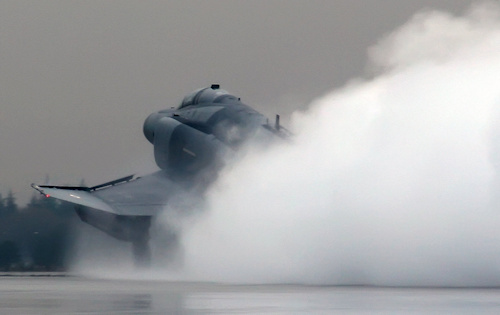
Deliveries proceeded fairly quickly and the first two specimens with identification serial numbers 73-1016 and 73-1017 arrived in Turkey on August 30, 1974, thus beginning the era of Phantom in Anatolian land.
As in the case of Greece, the Turkish F-4s also arrived too late to participate in the "Cyprus War", during which, in fact, they were the venerable F-100s Super Saber to shoulder the burden of supporting the landing forces of the Anatolian country. With the Cyprus file closed in a short time, THK continued in the work of receiving and integrating the F-4s into its departments, which happened quickly over the next two years. The first order was followed by a second one, called "Peace Diamond II", made up of 32 F-4Es and 8 RF-4Es, in April 1978, among which the 5000th Phantom manufactured by the St Louis factories.
A third contract, called "Peace Diamond III" was finalized between July 1981 and April 1984 and included 15 F-4Es recovered from the Aerospace Maintenance and Regeneration Center (AMARC), now renamed 309th Aerospace Maintenance and Regeneration Group (309th AMARG). Shortly thereafter, “Peace Diamond IV” followed which brought another 1984 F-1985Es already belonging to the USAF to Turkey between 15 and 4. In 1987 Turkey ordered another 40 F-4Es with the "Peace Diamond V" contract and finally, in 1991, as a reward for the help provided to the United States during the "Gulf War", with the "Peace Diamond VI" contract. 40 Air National Guard F-4Es were sold. In parallel, with the "Kaan Project", THK received 46 RF-4Es already in force at the German Luftwaffe, thus completing the supplies of F-4s to Turkey (although, for unknown reasons, they were supplied in followed by 1 more specimen). In this way the total of 237 F-4s ordered and delivered was reached (however, there are several sources that claim that Turkey actually received 251 Phantoms!). THE Phantom thus obtained they went to equip no less than 8 units within the structure of the THK:
- 111 “Panter” wire, based in Eskişehir, part of the 1 Ana Jet Üs (AJÜ), equipped with F-4E;
- 112 “Şeytan” wire, based in Eskişehir, part of the 1 Ana Jet Üs (AJÜ), equipped with F-4E;
- 113 “Işık” wire, based in Eskişehir, part of the 1 Ana Jet Üs (AJÜ), equipped with RF-4E;
- 171 “Korsan” line, based in Erhaç, part of the 7 Ana Jet Üs (AJÜ), equipped with F-4E;
- 172 Wire “Şahin”, based in Erhaç, part of the 7 Ana Jet Üs (AJÜ), equipped with F-4E;
- 173 “Şafak” line, based in Erhaç, part of the 7 Ana Jet Üs (AJÜ), equipped with RF-4E;
- 131 “Ejder” thread, based in Konya, part of the 3 Ana Jet Üs (AJÜ), equipped with F-4E;
- 132 “Hançer” line, based in Konya, part of the 3 Ana Jet Üs (AJÜ), equipped with a mixture of F-4E and F-5A.
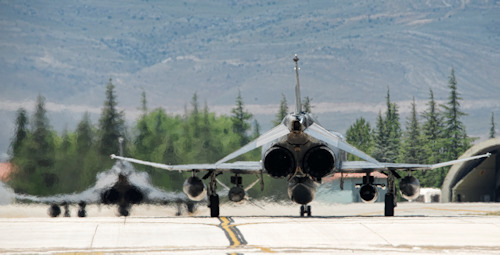 With the delivery of the F-4s, the United States also released a large amount of modern ammunition in the form of AGM-65A / B Maverick TV-guided air-to-ground missiles, GBU-10 laser-guided bombs. Paveway I and GBU-12 Paveway II, GBU-8 HOBOS electro-optic guided bombs and AN / AVQ-23 laser designation pods Pav Spike. In this way, for the first time since its inception, the Turkish Air Force gained the full capacity to carry out bombing operations using precision ammunition, exponentially increasing the ability to destroy well-protected and high-value targets. In the air-to-air sector, on the other hand, the sale by the Americans of the AIM-9B / P infrared guided short-range missiles Sidewinder and the AIM-7E semi-active radar-guided long-range missiles Sparrow ensured that, also in this sector, the F-4s guaranteed THK a state-of-the-art capability with the best international standards. Not only that, the package in transfer also included the pods for electronic countermeasures (ECM) Westinghouse AN / ALQ-119, one of the most effective then in service in the world, which exponentially improved Turkish capabilities in the electronic warfare sector and guaranteed the aircraft much greater protection from surface-to-air missile (SAM) threats.
With the delivery of the F-4s, the United States also released a large amount of modern ammunition in the form of AGM-65A / B Maverick TV-guided air-to-ground missiles, GBU-10 laser-guided bombs. Paveway I and GBU-12 Paveway II, GBU-8 HOBOS electro-optic guided bombs and AN / AVQ-23 laser designation pods Pav Spike. In this way, for the first time since its inception, the Turkish Air Force gained the full capacity to carry out bombing operations using precision ammunition, exponentially increasing the ability to destroy well-protected and high-value targets. In the air-to-air sector, on the other hand, the sale by the Americans of the AIM-9B / P infrared guided short-range missiles Sidewinder and the AIM-7E semi-active radar-guided long-range missiles Sparrow ensured that, also in this sector, the F-4s guaranteed THK a state-of-the-art capability with the best international standards. Not only that, the package in transfer also included the pods for electronic countermeasures (ECM) Westinghouse AN / ALQ-119, one of the most effective then in service in the world, which exponentially improved Turkish capabilities in the electronic warfare sector and guaranteed the aircraft much greater protection from surface-to-air missile (SAM) threats.
All Turkish F-4Es belonged to lots equipped with Westinghouse AN / APQ-120 radar which made them capable of carrying out air-to-air missions in all kinds of weather conditions, both day and night.
In the mid-90s, THK was faced with a dilemma. On the one hand, the deliveries of the Phantom were finished and the fleet of aircraft had reached maximum power and numerical consistency. On the other hand, having first flown in 1958, the F-4 was rapidly approaching its 40-year career and, although technologically it represented the best that the aviation industries had to offer in the 60s and 70s, by the 90s the original project was beginning to show clear signs of aging. There was also the pressing problem of intervening to "revitalize" the cells that had been subjected to an excessive workload during their intense operational life, and in many cases had even exceeded the number of flight hours assigned to each jet to be able to operate safely. Furthermore, the war scenarios had changed considerably both in the air-to-air and in the air-to-ground contexts where, in the first, the concept of the BVR combat fought with new types of self-hunting range missiles was imposed, while in the second the appearance of new platforms such as the McDonnell Douglas F-15E Strike Eagle and the Panavia Tornado had created much better equipped (but also more expensive) competitors to fulfill these missions more effectively than the venerable Phantom.
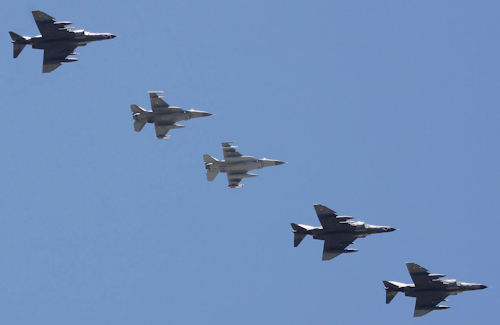 Economic reasons at that time made it impossible for Turkey to consider the option of purchasing a new aircraft (moreover just when the country was already engaged in the effort to integrate the General Dynamics F-16 Fighting Falcon while maintaining a large fleet of F-4s and F-5s!) therefore the forced choice was made to upgrade the F-4s. The first intervention, therefore, was to submit the entire fleet of Phantom Turks to a radical process of maintenance and structural strengthening of cells, similar to the Greek SLEP project already described in a previous analysis. Secondly, the RF-4E fleet underwent a separate modernization project to equip it with new sensors and photographic equipment. The third stage was intended to improve the air-to-air capabilities in the context of BVR.
Economic reasons at that time made it impossible for Turkey to consider the option of purchasing a new aircraft (moreover just when the country was already engaged in the effort to integrate the General Dynamics F-16 Fighting Falcon while maintaining a large fleet of F-4s and F-5s!) therefore the forced choice was made to upgrade the F-4s. The first intervention, therefore, was to submit the entire fleet of Phantom Turks to a radical process of maintenance and structural strengthening of cells, similar to the Greek SLEP project already described in a previous analysis. Secondly, the RF-4E fleet underwent a separate modernization project to equip it with new sensors and photographic equipment. The third stage was intended to improve the air-to-air capabilities in the context of BVR.
In this regard, 48 F-4Es were selected to be modernized by the TAI (Turkish Aerospace Industries) to the “Phantom 2000” standard. This update, inspired by the Israeli Kurnass 2000, included the integration of the ELTA EL / M-2032 radar and the ECM Mikes-Aselsan AN / ALQ-178 [V] 3 electronic countermeasures system, MXF-484 radio of the VHF / UHF type , HOTAS flight control systems, screens head up display (HUD), integrated INS / GPS navigation system, aerial video recording system (AVTR), multifunction color displays (MFD), new mission computer and MIL-STD-1553B data bus.
Although much of the avionics were of Israeli origin, the instruments with CRT screens of Turkish origin were considered superior while the ELTA EL / M-2032 radar, with detection capacity of 150 kilometers, greatly outperformed the Norden AN / APG- 76 of the Israeli Kurnass 2000. This radar allowed the improved F-4s in Turkey to become compatible with the AIM-9X missiles Sidewinder and AIM-120A / B AMRAAM significantly increasing the value of Phantom as platforms for both BVR and WVR air-to-air combat. The fourth stage, on the other hand, had to do with the enhancement of air-to-ground capabilities. This program was approved in 1996 and would eventually give rise to what many observers and enthusiasts of the aeronautical world have defined as the definitive version of the glorious twin-engine of St Louis: the McDonnell Douglas F-4E 2020T Terminator, also known simply as F-4E / 2020.
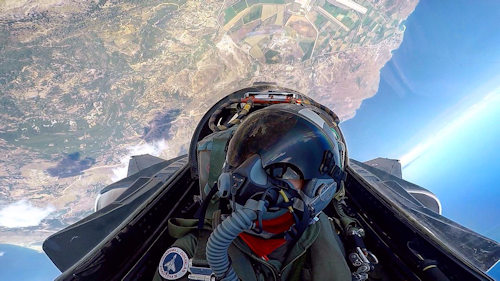 Underlying the program was a requirement for the modernization of 54 newly structurally upgraded F-4Es that were to receive new avionics also based on the Israeli Kurnass 2000 project but, unlike the Phantom 2000 modernized by TAI, i Terminator they would also have seen their ground attack capabilities grow exponentially.
Underlying the program was a requirement for the modernization of 54 newly structurally upgraded F-4Es that were to receive new avionics also based on the Israeli Kurnass 2000 project but, unlike the Phantom 2000 modernized by TAI, i Terminator they would also have seen their ground attack capabilities grow exponentially.
After a fierce competition between the German DASA (the same that had modernized the German F-4F ICE and the Greek F-4E AUP) and the Israeli IAI (Israel Aircraft Industries), the latter was declared the winner of a contract worth 600 million dollars which provided for the modernization of 26 aircraft in Israel and the other 28 in Turkey, based on kits provided by the Israelis themselves. The aircraft modernization work began in February 1997 and ended by 2003 with the delivery of all aircraft to the operational departments.
The "new" F-4E / 2020s were characterized by the presence of a new and rich avionics suite including: an ELTA EL / M-2035 ISAR radar with a range of 111,1 kilometers with SAR / GMTI capability (synthetic aperture radar / indicator ground moving targets), new EL-OP 976 wide angle HUD and HOTAS system, new IAIC mission computer and navigation system with GPS / INS and automatic terrain mapping, new communication and countermeasures systems (active pod ECM ELTA EL / L-8222 and passive alarm ECM Mikes-Aselsan AN / ALQ-178 [V] 3 SPEWS), new RWR.
The "Terminators" were also subjected to a complete rewiring of all internal circuits, many of which (for a total length of 20 kilometers) were eliminated because they were now redundant, leading to a weight reduction of 750 kg. These and other modifications applied to the aircraft structure made the F-4E / 2020s formidable platforms for aerial combat with flight and attack performance in all respects comparable with those of the F-15E Strike Eagle.
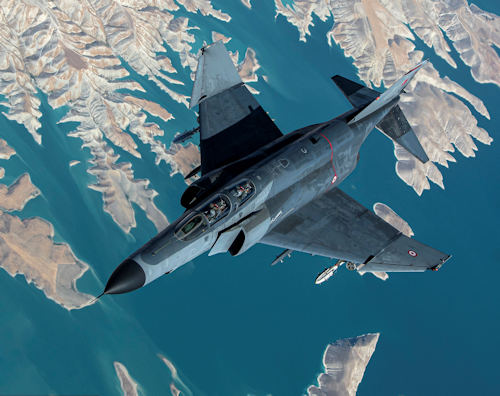 With the delivery of the last aircraft, in 2003, the "Terminator" program ended, but the Turkish F-4 fleet was upgraded again, in 2006 and then in 2009, with the "Işık" and "Şimşek" projects, this time of a purely national conception that we will not discuss in detail but which led to further improvements on the jet aircraft structures and further expanded the capabilities of the electronic suite by integrating new instrumentation and other improvements with the aim of maintaining the Phantom competitive until the year 2020.
With the delivery of the last aircraft, in 2003, the "Terminator" program ended, but the Turkish F-4 fleet was upgraded again, in 2006 and then in 2009, with the "Işık" and "Şimşek" projects, this time of a purely national conception that we will not discuss in detail but which led to further improvements on the jet aircraft structures and further expanded the capabilities of the electronic suite by integrating new instrumentation and other improvements with the aim of maintaining the Phantom competitive until the year 2020.
As regards the types of missions, armaments and external loads, the "Terminators" are in effect Phantom supreme ”and can carry out missions of any kind. For the reconnaissance missions, the "Terminators" have been enabled to carry the TARPS (Tactical Airborne Reconnaissance Pod System) and LANTIRN (Low Altitude Navigation and Targeting Infrared for Night) pods used in the mapping, damage assessment before and after the attack, oblique photorecognition and maritime surveillance. Although TARPS and LANTIRN cannot be carried by the same aircraft, they can nevertheless be used by different aircraft in the same formation, greatly increasing the mission capabilities of a single formation.
For air-to-air missions, the "Terminators" can use the AIM-7 semi-active radar-guided medium-range missiles in BVR scenarios Sparrow of the versions "E" and "F" and those with self-searching head "throw and forget" AIM-120 AMRAAM of the versions "A", "B" and "C-7", while in the WVR scenarios they rely on the AIM-9 Sidewinder versions "E", "F", "X", "M", "L", "I", "S" and "P3" as well as the integration of the nationally designed Gökdoğan and Bozdoğan missiles. Finally, for air-to-ground missions, the “Terminators” have at their disposal a large arsenal of free-fall or guided bombs and air-to-ground missiles of the most disparate types.
As free-fall bombs for general use we can mention the Mark 81/82/83/84 of American origin. In the cluster bombs sector, the CBU-58, CBU-100 and CBU-105 WCMD are also available, also of American origin. Always American are the laser guided bombs GBU-8 HOBOS, GBU-10 and GBU-12, the last two belonging to the series Paveway II and also of American origin are the anti-radiation bombs GBU-31 and GBU-38. These, moreover, can be transformed into guided bombs thanks to the help of JDAM kits of American origin, while the TÜBİTAK HGK and TÜBİTAK KGK kits of Turkish origin are intended for the Mark-84 and Mark-82 respectively.
Also of Turkish origin is the high penetration bomb TÜBİTAK NEB which supports the American BLU-109 / B in that role, which can also be used as an "anti-bunker" weapon. On the other hand, the highly effective "anti-runway" bombs Matra Durandal are French.
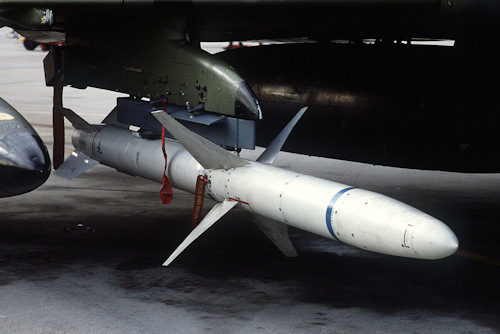 Even today, the guided missile most used by "Terminators" for attacking fixed or moving ground targets is the AGM-65 Maverick versions "A", "B" and "G", while the AGM-88B HARM (photo) is used for SEAD missions, both of US origin, such as the AGM-154A-1 / C JSOW which occupies the increasingly important niche of stand-off weapons.
Even today, the guided missile most used by "Terminators" for attacking fixed or moving ground targets is the AGM-65 Maverick versions "A", "B" and "G", while the AGM-88B HARM (photo) is used for SEAD missions, both of US origin, such as the AGM-154A-1 / C JSOW which occupies the increasingly important niche of stand-off weapons.
Finally, the field of air-launched cruise missiles for attacking land targets has been occupied for years by the Americans AGM-84 SLAM and AGM-84 H / K SLAM-ER and by the Israeli Lockheed Martin / Rafael AGM-142 Raptor / Popeye / Have Nap (the latter produced under license by the Turkish TAI) until the arrival of the SOM, one of the best cruise missiles currently in service in the world, developed by TÜBİTAK SAGE and manufactured by ROKETSAN.
The accuracy of all the aforementioned air-to-ground weapons can then be further increased through the use of aiming pods such as the AN / AVQ-23A / B Pav Spike, SNIPER and AN / AAQ-28 (V) LITENING II.
Like their American, Israeli and Iranian counterparts, the Turkish F-4s have also seen a very intense, albeit little known, war use and an active participation in exercises within NATO and beyond.
The front on which the Turkish F-4s were most involved was that of the Aegean and the Eastern Mediterranean since, since 1974, relations between Greece and Turkey have only become more complicated over the decades due to the crisis in Cyprus and the territorial disputes in which the two countries are embroiled. In this context, THK has since been engaged in a perennial showdown against the Hellenic EPA which involves daily violations of Greek airspace by Turkish aircraft, with the F-4s dominating thanks to the speed guaranteed by the thrust. of J79 engines. Those who think that these are trespasses of nothing are very wrong if you think that, from 1974 to today, THK has violated the Greek airspace an average of 363 times a month (!) And these are violations involving formations of 4 or even 8 aircraft at a time.
During the "Deliberate Force" operations, between 30 August and 20 September 1995, and "Allied Force", between 24 March and 10 June 1999, the Phantom Turks were mobilized in the roles of air defense and reconnaissance starting from the bases located in Italian territory, however in both situations they were not involved in fire actions against the Serbian forces. On the other hand, the commitment of the F-4s was very different during the endless conflict that it opposed and continues to oppose Turkey to the Kurdish PKK and to the other regional movements affiliated to it.
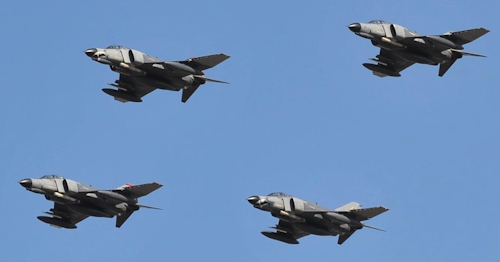 Since 1978, the Turkish Armed and Security Forces have been heavily engaged in a ferocious campaign to suppress the Kurdish insurgency, and the air forces have played a quintessential role in providing fire support to ground troops both in mountain operations. than in those held in an urban context. Given the versatility of the F-4 as operational platforms, it was obvious that they would also become the main attack vectors against the PKK bases located not only in the most remote areas of Turkey, but also in Iraq, Iran and, more recently , in Syria.
Since 1978, the Turkish Armed and Security Forces have been heavily engaged in a ferocious campaign to suppress the Kurdish insurgency, and the air forces have played a quintessential role in providing fire support to ground troops both in mountain operations. than in those held in an urban context. Given the versatility of the F-4 as operational platforms, it was obvious that they would also become the main attack vectors against the PKK bases located not only in the most remote areas of Turkey, but also in Iraq, Iran and, more recently , in Syria.
Providing below a detailed account of the air operations that saw the use of the F-4 under the Turkish cockades in operations against the Kurds is simply impossible; however some salient events can be mentioned:
-15 August 1986: during a Turkish incursion into Iraqi Kurdistan, a dozen F-4s flew tactical support missions to support the approximately 8.000 soldiers engaged in the operation;
-4 March 1987: about thirty F-4s participated in the bombing of three training camps of the PKK (known by the code names of “Sırat”, “Era” and “Alamış”) located in Iraqi Kurdistan;
- from 12 October to 1 November 1992: the F-4 of the THK provided tactical support to 20.000 Turkish soldiers and 5.000 their Iraqi Kurdish allies during the offensive against the Iraqi bases of the PKK called "Northern Iraq Operation" (Kuzey Irak Harekâtı );
-26 July 1994: bombing of the Kurdish bases in Northern Iraq;
- from 20 March to 4 May 1995: i Phantom they provided tactical support to over 35.000 Turkish soldiers engaged against the PKK bases in Northern Iraq during the offensive called “Operation Steel” (Çelik Harekâtı);
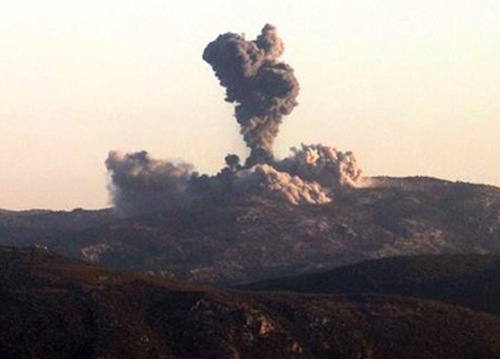
-14 June 1996: bombing and tactical support during a raid against the PKK guerrillas in Iraqi Kurdistan: “Operation Tokat” (Tokat Harekâtı);
- from 12 May to 7 July 1997: the F-4s and other combat aircraft of the Air Force were mobilized in support of the offensive called "Operation Hammer" (Çekiç Harekâtı) by 50.000 soldiers and 10.000 "Village Guards ”, With the aim of eradicating the presence of the PKK in Eastern Turkey and Northern Iraq;
- from 25 September to 15 October 1997: the F-4 of the THK bombed the Iraqi sanctuaries of the PKK in support of 15.000 Turkish soldiers and 8.000 their Kurdish allies of the Kurdistan Democratic Party: “Operation Alba” (Şafak Harekâtı);
- from April to May 1998: during the most important military operation in the history of the Republic of Turkey, "Operation Murat" (Murat Harekâtı), the F-4s helped to support tens of thousands of Turkish soldiers engaged in a massive roundup through the Turkish province of Hakkâri;
-from 16 to 26 December 2007: in what is still today the single most expensive military operation in the history of the Republic of Turkey (cost estimated at over 20 million dollars!), THK employed no less than 52 combat aircraft, including F-4 and F-16, to bomb the PKK training camps in Iraqi Kurdistan inflicting heavy losses on the organization's forces;
- from 21 to 29 February 2008: in what became known as "Operation Sun" (Güneş Harekatı) about 10.000 Turkish soldiers crossed the border between Turkey and Iraq and attacked the positions of the PKK and PJAK located in Iraqi Kurdistan. In anticipation of this operation, the Turkish F-4s and F-16s had begun hammering Kurdish positions since December 16, 2007 (the day the THK carried out its first night attack with "smart" weapons, when the F -4E / 2020 launched various AGM-65 Maverick and AGM-142 Raptor / Popeye / Have Nap against underground bunkers and hiding places) to then support the advance of the ground troops during the invasion. The air operations continued even after the cessation of the advance of the soldiers on the ground, with peaks recorded between 25 and 26 April and 1 and 2 May when the Turkish Armed Forces carried out some complex offensive military operations coordinating the action of self-propelled land artillery T-155 Fırtına, UAV IAI Heron, F-16 equipped with LANTIRN pods and F-4 fighter-bombers;
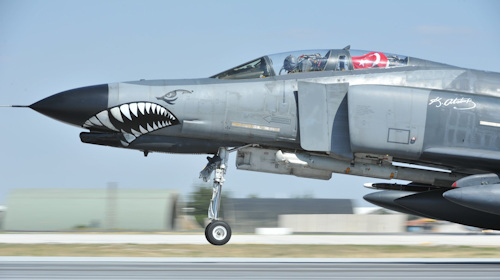
- from 17 to 24 August 2011: in response to a crescendo of attacks by the Kurdish guerrillas, the F-4 and F-16 of the Anatolian crescent hit 132 enemy targets while long-range artillery hit 349 others in an operation military overall lasted a week;
-from 11 June to 11 August 2012: during some of the most ferocious fighting in the history of the Turkish-Kurdish conflict, the F-4s carried out no less than 400 air raids directed against targets of the elusive enemy located in the province of Hakkâri;
- between 8 and 19 September 2012: the F-4s and other Turkish military aircraft bombed Kurdish targets both on Turkish soil, in the province of Hakkâri, and in the "sanctuary" of Qandil, located in Iraq, within the what will become known as "Operation Epic Silence" (Sessiz Destan Operasyonu);
-between 18 and 19 March 2016: in response to a series of bomb attacks which took place between February and March, Ankara launched a new wave of aerial bombardments with 30 between F-4 and F-16 aimed at hitting PKK targets in the Northern Iraq;
-between May 28, 2019 and June 15, 2020: as part of the longest anti-guerrilla operation in the history of the Republic of Turkey, called "Operation Claw" (Pençe Harekatı), the Turkish Army, the Gendarmerie and the "Village Guards" conquered large areas of Iraqi Kurdistan forcing the Kurdish guerrillas to abandon the bases located along the border area and retreat to the Qandil area. In the course of the succession of operations, the F-4E / 2020 and the F-16 of the THK, as well as the combat helicopters and drones have been extensively used to hit PKK targets and provide tactical support to the ground troops;
- between 15 June 2020 and 5 September 2020: Turkey used the F-4E / 2020 together with other aircraft and drones also during the most recent anti-guerrilla operations in Iraq, called "Operation Eagle Claw" (Pençe -Kartal Operasyonu) and “Operation Tiger's Claw” (Pençe-Kaplan Operasyonu) aimed at further pursuing the Kurdish guerrillas in the Qandil mountains.
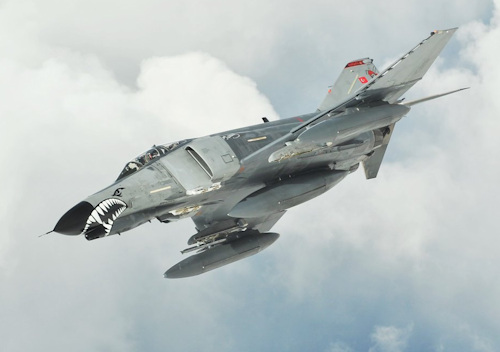 The last decade has also seen an increase in the warfare activities of the fleet of Phantom Turks as a consequence of the deterioration of the geopolitical situation of neighboring Syria and the Turkish attempts to destabilize it. On 22 June 2012, while Syria was sinking in the hell of war, a Turkish RF-4E, belonging to the 173 Filo "Şafak", engaged on a reconnaissance mission along the coastal stretch of Syria, with flight lieutenant Gökhan at the controls Ertan and flight officer Hasan Hüseyin Aksoy, was shot down by a Pantsir-S1 missile system (NATO codename: SA-22 Greyhounds) with the death of both pilots, formally marking the beginning of Turkish involvement in the so-called "Syrian Civil War".
The last decade has also seen an increase in the warfare activities of the fleet of Phantom Turks as a consequence of the deterioration of the geopolitical situation of neighboring Syria and the Turkish attempts to destabilize it. On 22 June 2012, while Syria was sinking in the hell of war, a Turkish RF-4E, belonging to the 173 Filo "Şafak", engaged on a reconnaissance mission along the coastal stretch of Syria, with flight lieutenant Gökhan at the controls Ertan and flight officer Hasan Hüseyin Aksoy, was shot down by a Pantsir-S1 missile system (NATO codename: SA-22 Greyhounds) with the death of both pilots, formally marking the beginning of Turkish involvement in the so-called "Syrian Civil War".
Throughout the conflict, first sporadically and then, starting from mid-2015, systematically, the "Terminators" were used on several occasions by THK to attack targets of the PKK, the Syrian Kurds and, occasionally, the 'ISIS (those few times that Turkey and ISIS have actually come to blows). These aerial actions by the F-4s occurred episodically, such as on September 19 and November 15, 2015, and on January 12 and March 15, 2016, or in the context of large-scale operations such as:
-the "Operation Martyr Yalçın" (Şehit Yalçın Operasyonu): series of aerial bombardments with the ultimate aim of destroying PKK and ISIS targets located along the entire border between Syria and Turkey, but also in Northern Iraq, which occurred between 24 and 25 July 2015;
-the "Operation Euphrates Shield" (Fırat Kalkanı Harekâtı): offensive in a grand style carried out by the Armed Forces of Turkey in collaboration with their "auxiliaries" of the so-called "Free Syrian Army", which lasted over seven months (from 24 August 2016 to March 29, 2017) and resulting in the occupation by Turkish forces of a large swath of Syrian territory located in the northern area of the province of Aleppo;
-the air campaign in April 2017: a series of bombings aimed once again at the logistical infrastructure of both the PKK and the Syrian Kurds both in Syria and Iraq;
- the "Operation Olive Branch" (Zeytin Dalı Harekâtı): military offensive which lasted between January 20 and March 24, 2018 with which Turkish forces and their jihadist auxiliaries eradicated the Kurdish presence from the so-called "canton of Afrin", in northwestern Syria;
-the "Operation Source of Peace" (Barış Pınarı Harekâtı): invasion of a large portion of northeastern Syria in the period between 9 October and 25 November 2019 which led to the elimination of the Kurdish presence in the area.
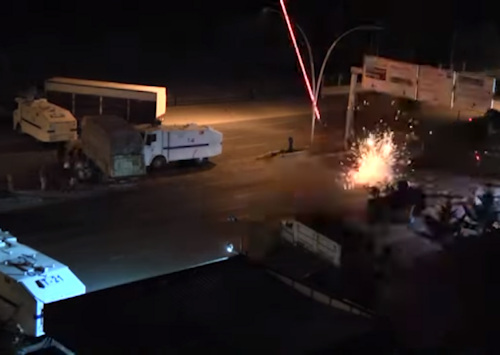 However, the real "moment of glory" of the F-4s in service at THK occurred in the night between 15 and 16 July 2016 when they played a leading role in defeating the attempted coup aimed at deposing the "president- master ”of Turkey, Recep Tayyip Erdoğan, and dissolve its government. On that occasion, the coup leaders, grouped in the so-called "Peace Council", had concentrated important aerial assets at the "Akıncı Air Base" (Akıncı Hava Üssü) including, among others: 37 helicopters (including Sikorsky S-70 Black HawkBell AH-1 Cobra and Eurocopter AS532 Cougar), 8 transport aircraft (including Transall C-160, Lockheed C-130 Hercules and Airbus A400M Atlas), 4 Boeing KC-135R aircraft refuelers Stratotanker and 24 General Dynamics F-16 fighters Fighting Falcon.
However, the real "moment of glory" of the F-4s in service at THK occurred in the night between 15 and 16 July 2016 when they played a leading role in defeating the attempted coup aimed at deposing the "president- master ”of Turkey, Recep Tayyip Erdoğan, and dissolve its government. On that occasion, the coup leaders, grouped in the so-called "Peace Council", had concentrated important aerial assets at the "Akıncı Air Base" (Akıncı Hava Üssü) including, among others: 37 helicopters (including Sikorsky S-70 Black HawkBell AH-1 Cobra and Eurocopter AS532 Cougar), 8 transport aircraft (including Transall C-160, Lockheed C-130 Hercules and Airbus A400M Atlas), 4 Boeing KC-135R aircraft refuelers Stratotanker and 24 General Dynamics F-16 fighters Fighting Falcon.
During that fateful night, the helicopters and F-16s of the coup forces took off, passing over the main Turkish cities at low flight and subsonic speed, strafing the government buildings (including the Parliament) manned by the loyalists, thus causing way dozens of victims.
A section of F-16s also attempted to intercept Erdoğan's Gulfstream VIP which in the meantime had left its resort in Marmaris in an attempt to reach Istanbul. It is not clear whether the order received by the coup pilots was to kill Erdoğan in flight or to land his plane in Akıncı so that he could be taken prisoner and tried by a "revolutionary court" organized ad hoc by the military. The fact is that the pilots of the presidential plane managed to buy time by turning off the transponder and the external positioning lights and "hiding" the Gulfstream in the wake of several airliners that at that moment were crossing the skies of Turkey. Confused by this maneuver, the pilots of the F-16 coup leaders were then dispersed by the emergency response of the F-4E / 2020 belonging to the 111 Filo "Panter" and the 171 Filo "Korsan" which took off from the Eskişehir base where they had converged for an exercise provided earlier. They had been the only ones of all the pilots of the THK flight departments to immediately respond to the call to arms on live TV from President Erdoğan and Prime Minister Binali Yıldırım as soon as it became clear to all that a full blown coup it was happening in the country.
The intervention of the F-4E / 2020 proved decisive not only because they allowed Erdoğan's Gulfstream VIP to land in Istanbul without danger, but also because, subsequently, they shot down 2 helicopters of the coup leaders and, last but not least, bombed the base of Akıncı, literally riddling the runway that was hit by no less than 12 high-potential disruptive bombs. With the runway of the Akıncı base now out of action, the coup leaders had no choice but to raise the white flag and surrender; the "Terminators" had "finished" the coup.
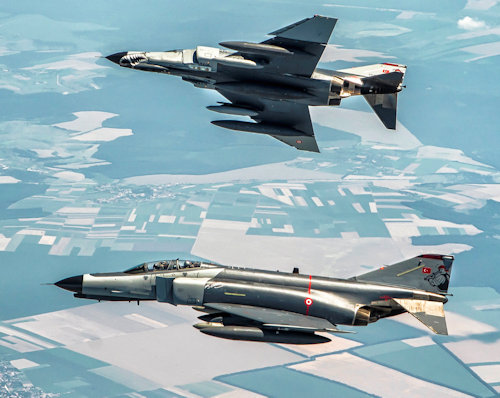 Despite the brilliant overall performance and these undeniable successes, it seemed clear to most that the F-4 career with the THK was destined to end by the end of this decade. It is not clear how many Phantom have been supplied to Turkey since the sources do not agree on this point (most speak of 233 or 237 but some even speak of 251!) however the Anatolian power has never really managed to deploy the entire fleet at the maximum of its power.
Despite the brilliant overall performance and these undeniable successes, it seemed clear to most that the F-4 career with the THK was destined to end by the end of this decade. It is not clear how many Phantom have been supplied to Turkey since the sources do not agree on this point (most speak of 233 or 237 but some even speak of 251!) however the Anatolian power has never really managed to deploy the entire fleet at the maximum of its power.
The intense use both in "peace" and in war and a series of problems caused by the lack of discipline and by a sometimes incomplete maintenance meant that, immediately, the Turkish F-4s were exposed to a very high rate of losses due to accidents that the Aviation Safety Network has quantified in no less than 60 aircraft (!) from the introduction of the model in 1974 until today. Furthermore, despite the Phantom had been updated in waves through the various programs "Phantom 2000", "Terminator", "Işık" and "Şimşek", no one expected their stay in service beyond 2020, the year in which they should finally have been replaced by the Lockheed Martin F- 35 Lightning II.
Although in 2010 the THK still counted no less than 194 Phantom between its ranks (40 RF-4E, 52 unmodified F-4E, 48 F-4E Phantom 2000 and 54 F-4E 2020T Terminator), in the following years the aircraft began to be withdrawn at a sustained pace, starting with the reconnaissance aircraft and aircraft subjected to minor modifications, then following with the most technologically advanced ones, while the flight departments were "deactivated ”And placed in“ switchboard positions ”waiting to receive the F-35s of which Turkey wanted to buy 120 copies of the“ A ”version for the Air Force and 32 of the“ B ”version for the Navy. However, due to the finalization of the contract between Turkey and Russia for the supply of four batteries equipped with 36 fire units of S-400 anti-aircraft missiles Arc (NATO codename: SA-21 Growler), the United States has decided to punish Ankara, first by blocking the supply of any aircraft in the bud, and then by totally excluding the Turks from the program, inflicting a severe blow to the Anatolian country's defense industries, among other things.
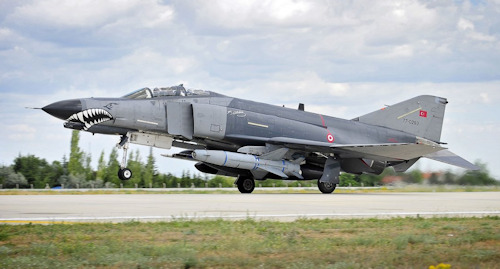 Today, 46 years after its entry into service and after having accumulated a total of several million flight hours with the THK, the F-4 is still in service in 49 units, all belonging to the advanced version F-4E / 2020, with the 111 Filo "Panter" and with the 401 Test Filosu, both based in Eskişehir, while other 3 former F-4 units are in a state of "limbo", awaiting aircraft with will never arrive, and it is not certain that Finally, Ankara does not resign itself to pulling a certain number of prematurely disbanded F-4s out of warehouses to put them back into service and thus try to replenish the ranks of its air force. If this eventuality were to materialize, it would be a resounding "return" as in the best Hollywood traditions, but yes you know, the history of cinema teaches us that it would not be the first time that a "Terminator" returns.
Today, 46 years after its entry into service and after having accumulated a total of several million flight hours with the THK, the F-4 is still in service in 49 units, all belonging to the advanced version F-4E / 2020, with the 111 Filo "Panter" and with the 401 Test Filosu, both based in Eskişehir, while other 3 former F-4 units are in a state of "limbo", awaiting aircraft with will never arrive, and it is not certain that Finally, Ankara does not resign itself to pulling a certain number of prematurely disbanded F-4s out of warehouses to put them back into service and thus try to replenish the ranks of its air force. If this eventuality were to materialize, it would be a resounding "return" as in the best Hollywood traditions, but yes you know, the history of cinema teaches us that it would not be the first time that a "Terminator" returns.
Regardless of all this, the McDonnell Douglas F-4E 2020T Terminator of Türk Hava Kuvvetleri continue to fly and serve their country daily, in war as in "peace", fulfilling the plurality of missions for which they were designed, and will continue to do so for the foreseeable future, until their destiny final will be decided once and for all. And even if, eventually, their demise is inevitable and their "race" is doomed to extinction, we can confidently say that it will ... but not today.
Photo: Türk Silahlı Kuvvetleri / US DoD / web












